Scientific papers 2018





In this document, Wienke & O'Leary attempt a short
history of deep and shallow stops by taking into account
physical aspects, staging differences, diving tests, models
with data correlations, and data banks with user statistics.
Pros and cons of deep and shallow stops are presented,
and what they consider misfacts are righted.
Also, they discuss the various tests, training agency
standards, commercial diving operations, and dive
software linked to this topic.


Authors:
Alf O Brubakk, Randi Eidsmo Reinertsen, V. Flook, & S.
Koteng
Abstract:
Reduction in ascent speed and an increase in the O2
tension in the inspired air have been used to reduce the
risk for decompression sickness. It was previously reported
that decompression speed and O2 partial pressure are
linearly related to human decompressions from saturation
hyperbaric exposures. The constant of proportionality K (K
5 rate/partial pressure of inspired O2) indicates the
incidence of decompression sickness. This study
investigated the relationship between decompression
rate, partial pressure of inspired O2, and the number of
central gas bubbles after a 3-h dive to 500 kPa while
breathing nitrox with an O 2 content of 35 kPa.


Authors: Joe KS Leung, Rex PK Lam
Hyperbaric oxygen therapy is widely accepted as a life-
saving treatment for decompression illness.
Yet, its use in acute carbon monoxide poisoning has
remained controversial because of inconsistent findings in
clinical trials. Hyperbaric oxygen therapy has an adjunctive
role in managing gas gangrene, necrotising soft-tissue
infection, and crush injury, as supported by the case
series. Several cases have been reported in the literature
detailing the use of hyperbaric oxygen therapy in patients
with severe anemia in whom blood transfusion is not
possible.
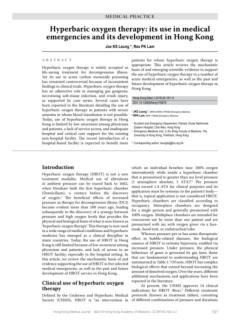

Authors:
Serena Lucrezi, Salih Murat Egi, Massimo Pieri, Francois
Burman, Tamer Ozyigit, Danilo Cialon, Guy Thomas,
Alessandro Marroni, and Melville Saayman.
Scuba diving is an important marine tourism sector but
requires proper safety standards to reduce the risks and
increase accessibility to its market. To achieve safety goals,
safety awareness and positive safety attitudes in
recreational scuba diving operations are essential.
However, there is no published research exclusively
focusing on scuba divers’ and dive centres’ perceptions
toward safety. This study assessed safety perceptions in
recreational scuba diving operations, with the aim to
inform and enhance safety and risk management
programs within the scuba diving tourism industry.
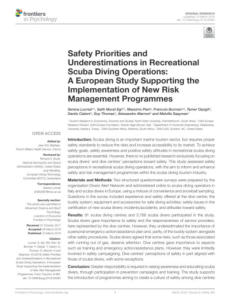

Authors:
Isaac Peña-Villalobos, Ignacio Casanova-Maldonado,
Pablo Lois, & Catalina Prieto.
This paper does not speak of diving but of hyperbaric
oxygen therapy (HBOT) to solve diverse diseases,
infections, and tissue injuries. However, this study
highlights other therapeutic effects of oxygen than those
commonly explained to divers.
This study's authors analyze the effects of HBOT on
specific aspects of tissue growth, maintenance, and
regeneration to provide answers on how this treatment
could benefit from combination with regenerative
medicine strategies.


Authors:
Fatima Z. Kiboub, Costantino Balestra, Øyvind
Loennechen, Ingrid Eftedal.
Saturation divers are exposed to elevated partial pressure
of oxygen (ppO2) in their hyperbaric work environment.
Experimental studies indicate that oxygen transport is
altered, and the authors previously reported a drop in
hematocrit and extensive downregulation of genes
involved in blood oxygen transport capacity after
decompression from professional saturation diving. This
study investigates the initial period of hematological
adjustment back to normobaric air after professional
saturation diving.
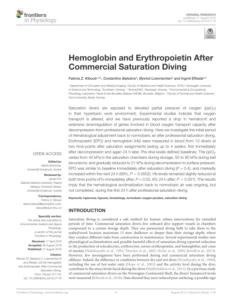

Authors:
Gerardo Bosco, Alex Rizzato, Luca Martani, Simone
Schiavo, Ennio Talamonti, Giacomo Garetto, Matteo
Paganini, Enrico M. Camporesi, and Richard E. Moon.
The present study aimed to evaluate the partial pressure of
arterial blood gases in breath-hold divers performing a
submersion at 40 m. Eight breath-hold divers were
enrolled for the trials held at the “Y-40 THE DEEP JOY”
pool (Montegrotto Terme, Padova, Italy).
Prior to submersion, an arterial cannula in the radial artery
of the non-dominant limb was positioned.
All divers performed a sled-assisted breath-hold dive to 40
m. Three blood samplings occurred: at 10 min prior to
submersion, at 40 m depth, and within 2 min after diver’s
surfacing and after resuming normal ventilation.
Blood samples were analyzed immediately on site.
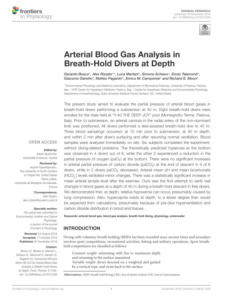

Authors:
Jean-Eric Blatteau, Sandrine Gaillard, Sébastien De
Maistre, Simone Richard, Pierre Louges, Emmanuel
Gempp, Arnaud Druelles, Henri Lehot, Jean Morin, Olivier
Castagna, Jacques H. Abraini, Jean-Jacques Risso,
Circulating mitochondrial DNA (mtDNA) is receiving
increasing attention as a danger-associated molecular
pattern in conditions such as autoimmunity or trauma. In
the context of decompression sickness (DCS), the course
of which is sometimes erratic, the authors hypothesize
that mtDNA plays a not insignificant role, particularly in
neurological type accidents. This study is based on the
comparison of circulating mtDNA levels in humans
presenting with various types of diving accidents and
punctured upon their admission at the hyperbaric facility.
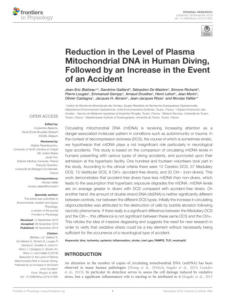

Authors:
Blair D. Johnson, Morgan C. O’Leary, Muhamed McBryde,
James R. Sackett, Zachary J. Schlader, & John J. Leddy.
The authors tested the hypothesis that concussed college
athletes have attenuated parasympathetic and
sympathetic responses to face cooling.
The experimentations described in this document were
not made with divers. However, the phenomenon
described will happen when the face of the diver is
exposed to cold water.


Authors:
Gerardo Bosco, Alex Rizzato, Silvia Quartesan , Enrico
Camporesi, Devanand Mangar, Matteo Paganini, Lorenzo
Cenci, Sandro Malacrida, Simona Mrakic-Sposta, Sara
Moretti, & Antonio Paoli.
Central Nervous System Oxygen Toxicity (CNS-OT) is one
of the most harmful effects of Enriched Air Nitrox (EAN)
diving. Protective factors of the Ketogenic Diet (KD) are
antioxidant activity, the prevention of mitochondrial
damage, and anti-inflammatory mechanisms. This study
investigated whether a short-term KD may reduce
oxidative stress and inflammation during a hyperoxic dive.


Authors:
Mikael Gennser, S. L. Blogg, Ola Eiken, and Igor B.
Mekjavic
Human extravehicular activity (EVA) is essential to space
exploration and involves the risk of decompression
sickness (DCS). On Earth, the effect of microgravity on
physiological systems is simulated in an experimental
model where subjects are confined to a 6 degres head-
down bed rest (HDBR). This model investigated various
resting and exercise regimens for forming venous gas
emboli (VGE), an indicator of decompression stress, post-
hyperbaric exposure.
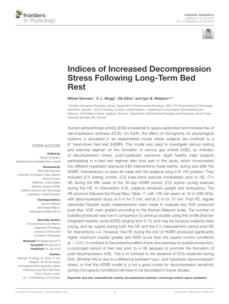

Authors: BR Wienke and TR O’Leary
The question of bubble regeneration and broadening in
the diver under compression-decompression is virtually
unanswered and untractable. Effects in vivo have not
been measured nor quantified to date and remain
unlikely soon. The authors take up this question and
suggest hypothetical impacts on diver staging using
available data and recent experimental results in the
laboratory.


Author: Ran arieli
Pulmonary surfactants are surface-active lipoproteins
deposited in clearly defined areas on the luminal aspect
of blood vessels. Bubbles nucleate and grow at these
spots after decompression from high pressure. Proteins
with hydrophobic regions circulating in the blood will
adhere to the gas phase-plasma interface. Deformation of
their secondary and tertiary configuration will present
them as foreign molecules or autoantigens. Components
of the intact protein also present in a deformed protein
may be recognized as foreign too.


Authors: Barbara E. Shykoff & John P. Florian
This study examines differential effects of immersion,
elevated oxygen partial pressure, and exercise on
pulmonary function after series of five daily six-hour dives
at 130 kPa (1.3 ATA), with 18 hours between dives.


Author: Pierre Boudinet
The author of this study presents a new way of taking into
account the dynamics of the gas phase during
decompression. This study is based on the analysis of
certain hypotheses underlying classical models using
Maximal Values (M-Values). The author derives a reduced
set of ordinary differential equations, depending only on
three empirical parameters. After having explained how
the theory is built, the author proposes some values of the
parameters that match the known surface M-Values
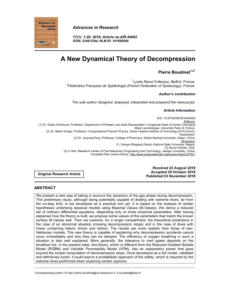

Authors:
Martin J. Barwood, Jo Corbett, Heather Massey, Terry
McMorris, Mike Tipton, and Christopher R. D. Wagstaff
Drowning is a leading cause of accidental death. In cold-
water, sudden skin cooling triggers the life-threatening
cold shock response (CSR). The CSR comprises
tachycardia, peripheral vasoconstriction, hypertension,
inspiratory gasp, and hyperventilation with the
hyperventilatory component inducing hypocapnia and
increasing risk of aspirating water to the lungs.
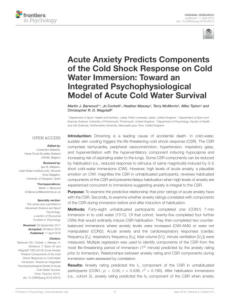

Authors:
Bin Peng, Shun-Hua Peng, Run-Ming Qu, Li-Hua Xu,
Zheng-Lin Jiang
Human beings are exposed to compressed air or a
nitrogen-oxygen mixture, they will produce signs and
symptoms of nitrogen narcosis such as amnesia or even
loss of memory, which may disappear once back to the
normobaric environment. This study was designed to
investigate the effect of nitrogen narcosis induced by
repetitive hyperbaric nitrogen-oxygen mixture exposure
on long-term cognitive function in newborn mice and the
underlying mechanisms.


Authors: Carelli M, Laurino M, Zaccaro A, Lai E, Passera M,
Gemignani A
Nitrogen Narcosis is a reversible syndrome affecting divers
performing deep dives breathing air.
Symptoms go from euphoria, slow reasoning and reaction
time, impaired motor coordination, to complete loss of
consciousness. Symptoms severity increases as the
nitrogen partial pressure increases, with depth.
This document is a 1 page PDF designed to be displayed
on a large screen
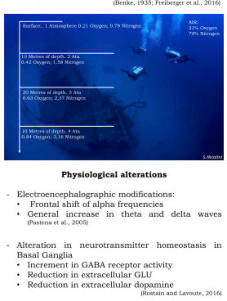

Authors:
Pierre Lafère, Peter Germonpré, François Guerrero,
Alessandro Marroni, Costantino Balestra
Because a significant association between training to
perform emergency free ascent (EFA) and the occurrence
of pulmonary barotrauma (PBT) was demonstrated in
2006, the Belgian Underwater Federation (BUF) decided
to discontinue this procedure. An evaluation was needed
10 yr after the implementation of this change.
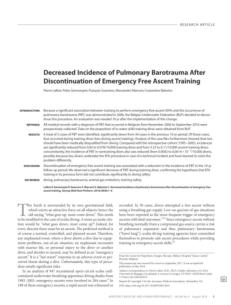

Authors:
Çigdem Özer Gökaslan, Ugur Toprak, Serkan Gokaslan
High-pressure water injuries are usually seen in the
extremities and less often in the thorax and abdominal
areas. A literature review reveals a few case reports
describing intra-abdominal injuries due to penetrating
trauma. This paper presents the radiological findings of a
rare case of abdominal wall injury without penetration of
the peritoneum caused by a high-pressure water jet due
to the Coanda effect. The Coanda effect is the tendency of
a fluid jet to stay attached to a curve.
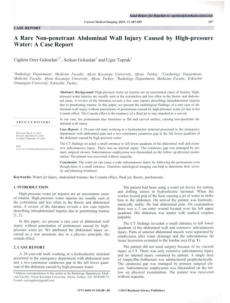

Authors:
Gerardo Bosco, Alex Rizzato, Richard E. Moon, and Enrico
M. Camporesi
This paper illustrates the physiological changes induced by
immersion, swimming, breath-hold diving and exploring
while using special equipment in the water.
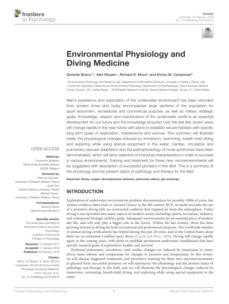

Authors:
Giuseppe Accurso, Andrea Cortegiani, Sabrina Caruso,
Oriana Danile, Domenico Garbo, Pasquale iozzo, Filippo
Vitale, Santi Maurizio Raineri, Cesare Gregoretti, &
Antonino Giarratano
The authors report two episodes of Taravana syndrome
occurred in the same young male spear fishing champion
affected by hyperho-mocysteinemia treated with
recompression treatment at the Hyperbaric Oxygen
Therapy (HBOT) Department of the University Hospital
Policlinico Paolo Giaccone, Palermo, Italy, in November
2010 and July 2016.
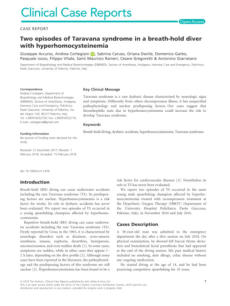

Authors:
Q. Buzzacott, D. Schiller, J. Crain, and P. Denoble
This study, published in 2018, investigated morbidity and
mortality suffered by divers in the US and Canada.


Author: Ran Arieli
Taravana is a neurological form of decompression illness
(DCI) prevalent in repeated breath-hold diving. A
nanobubble on an active hydrophobic spots (AHS) in a
distal artery of the brain may receive an influx of nitrogen
after each dive until it occludes the arterial blood flow. The
vestibular organ has very low perfusion compared with
the brain and the cochlea of the inner ear. The author
suggests that a nanobbubble on an AHS in the distal
artery of the vestibular organ will receive a high influx of
nitrogen from the surrounding tissue after decompression
due to the low nitrogen clearance, thus expanding to
cause vestibular DCI.


Author: Alice Bliznyuk, Hava Golan, & Yoram Grossman
Divers that are exposed to high pressure (HP) above 1.1
MPa suffer from High Pressure Neurological Syndrome
(HPNS), which is implicated with central nervous system
(CNS) malfunction. Marine mammals performing
extended and deep breath-hold dives are
exposed to almost 20 MPa without apparent HPNS
symptoms. N-methyl-D-aspartate receptor (NMDAR) has
repeatedly been implicated as one of the major factors in
CNS hyperexcitability as part of HPNS. Electrophysiological
studies in rat brain slices at He HP showed a significant
increase in the synaptic NMDAR response, followed by
postsynaptic excitability changes.


Authors:
Thiago Felipe dos Santos Barros, Renata Gregorio Paulos,
Fernanda do Carmo Iwase, Gustavo Bispo dos Santos,
Marcelo Rosa de Rezende, Rames Mattar Júnior
This study aims to evaluate histological changes in the
peripheral nerves of rats after sciatic nerve neurorrhaphy,
based on the duration of exposure to hyperbaric oxygen
chamber treatment.
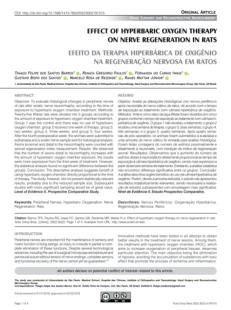



Authors: F. Gregory Murphy, Ashleigh J. Swingler, Wayne
A. Gerth, Laurens E. Howle
Decompression sickness (DCS) in humans is associated
with reductions in ambient pressure that occur during
diving, aviation, or certain human spaceflight operations.
Probabilistic models of DCS allow predicting the
probability of DCS occurrence and the time of occurrence
during or after a given hyperbaric or hypobaric exposure,
based on how the gas contents or gas bubble volumes in
hypothetical tissue compartments vary during the
exposure. These models are calibrated using data
containing the pressure and inspired gas histories of real
exposures.
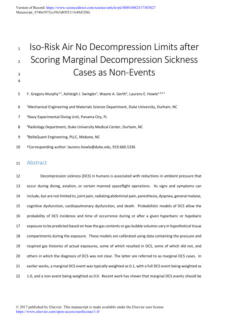

Authors: Antonin Povolny, Hiroshige Kikura, & Tomonori
Ihara
The ultrasonic pulse-echo technique makes it possible to
detect each bubble and measure the position of its
surface accurately. However, it has only been used to
measure individual bubbles so far. This paper investigates
whether the pulse-echo technique can be used to
measure multiple bubbles simultaneously.
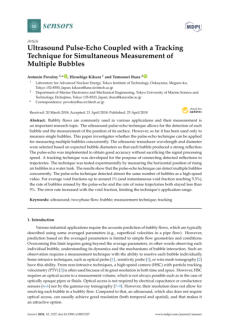
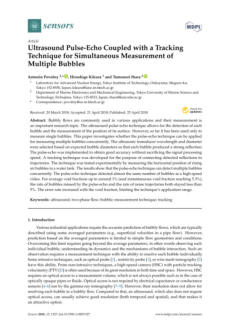

Authors: Ahmed Mohammed Aldakhil, Abdullah Faraj
Alshammari, Sattam Saad Alshammar
This article aims to assess dental and temporomandibular
joint (TMJ) problems in a sample of SCUBA divers in
Jeddah, Saudi Arabia. This study assesses dental
complaints and TMJ problems associated with SCUBA
diving, as well as the correlation of previous problems
with diving-related characteristics such as duration of
practice, number of dives, and frequency of diving per
month.
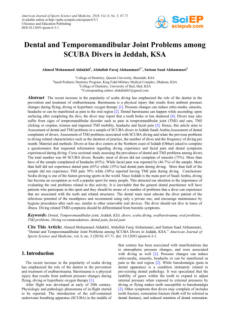

Authors: Pieter Jan AM van Ooij
A relationship between body composition and DCS has
been observed in dogs since the nineteenth century. In
the author's experience, it was not always the overweight
diver who ended up in the treatment chamber with DCS.
Gender, age, physical fitness, and the presence of a patent
foramen ovale (PFO) have all been studied as possible
factors in the development of vascular gas bubbles and,
therefore, DCS. However, none of these factors, alone or
in combination, explains why there are intra-individual or
intra-cohort differences in bubble grade.
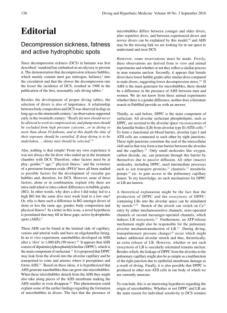

Authors:
Julien Hugon, Asya Metelkina, Axel Barbaud, Ron Nishi,
Fethi Bouak, Jean-Eric Blatteau, Emmanuel Gempp
This retrospective study reviewed data from 1,016
manned air dives, including dive parameters (depth,
bottom time, and total ascent time), precordial and
subclavian venous gas embolism grades (Kisman-Masurel)
and post-dive decompression sickness status. The study
analyzed the correlation between subclavian and
precordial grades, as well as the association between the
probability of decompression sickness (DCS) and dive
parameters, including high bubble levels.
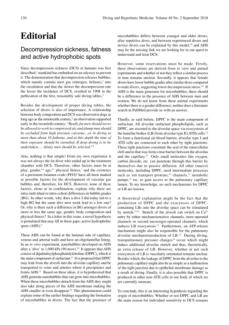

Author: B.R. Wienke
The risks of decompression sickness associated with
arbitrary ascents to depths above the diver and the risks of
surfacing are not yet encoded in underwater equipment
and diveware, and this is the focus here. Assessing risks is
necessary for diver safety and sensible dive planning. The
authors define and discuss exponential risk functions for
dissolved gas and bubble models, specifically the end-of-
dive (EOD) and on-the-fly (OTF) functions, using profile
data correlated with a database
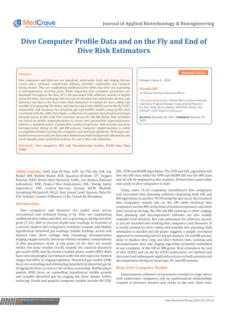


Click on the octopus
to return to the top
of the page



Authors:
Yeonsik Noh, Hugo F. Posada-Quintero, Yan Bai, Joseph
White, John P. Florian, Peter R. Brink, and Ki H. Chon
This study investigates the effects of prolonged and high-
pressure SCUBA diving on the autonomic nervous system
(ANS) by collecting and analyzing electrocardiogram
(ECG) data from divers at different depths and using
different gas mixes to understand how diving conditions
affect cardiac ANS behaviour, with particular emphasis on
the dynamics of sympathetic and parasympathetic activity.
It details the methodology, including the use of a Holter
monitor and a novel algorithm for ANS assessment, and
presents results showing changes in parasympathetic and
sympathetic activities under different diving conditions.
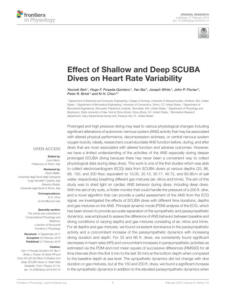

Authors:
Kate Lambrechts, Sébastien de Maistre, Jacques H. Abraini,
Jean-Eric Blatteau, Jean-Jacques Risso, and Nicolas Vallée
This study investigates the effectiveness of antiplatelet
drugs, specifically those targeting the GPIIb/IIIa integrin, in
preventing decompression sickness (DCS) using a rat
model. It aims to confirm that these drugs, particularly
tirofiban (TIR), can improve clinical outcomes and reduce
the incidence of DCS by limiting platelet activation and
subsequent inflammatory responses. This study also raises
questions about the potential drawbacks of inhibiting
other integrins, such as alpha-V-beta-3 and alpha-Mbeta-2,
which are involved in immune system communication..


Authors: Asadullah Naqvi, and Derrick Clarence
This study highlights the complexities and diagnostic
challenges associated with decompression illness (DCI) in
scuba divers. It emphasizes the need to consider multiple
possibilities and co-existing pathologies when diagnosing
and treating patients and that DCI can present with
atypical symptoms. Also, it describes the case of a 42-year-
old male who experienced symptoms post-scuba diving,
detailing the diagnostic and recovery processes and the
role of a patent foramen ovale in exacerbating DCI.
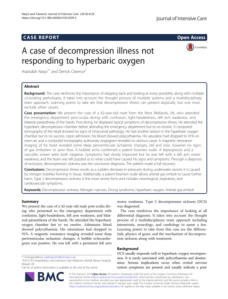

Authors:
Gerardo Bosco, Alex Rizzato, Silvia Quartesan, Enrico
Camporesi, Simona Mrakic-Sposta, Sarah Moretti,
Costantino Balestra, Alessandro Rubini
This study investigates the effects of hyperbaric and
hyperoxic exposure using scuba or closed-circuit
rebreather (CCR) on divers to determine whether acute
exposure to oxygen-enriched environments during diving
affects respiratory performance and oxidative state, using
spirometry and biomarkers of oxidative damage as
measures. It concludes that oxidative stress increases with
CCR use but does not impact pulmonary function.
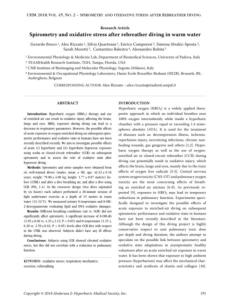

Authors: Ran Arieli
This paper provides a detailed scientific explanation of the
mechanisms and conditions leading to decompression
illness (DCI), particularly focusing on the formation and
expansion of gas bubbles from nanobubbles in the body.
It explains the physiological and biochemical processes
involved, the potential sources of gas micronuclei, and the
implications for different tissues and structures in the
body.
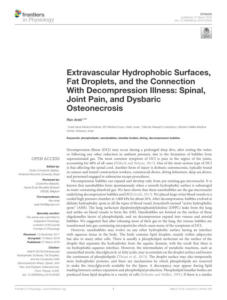

Authors:
Karl Shreeves, Peter Buzzacott, Al Hornsby, Mark Caney
The authors of this document present the findings of a
study that investigates the relationship between violations
of accepted diving practices and diver fatalities to highlight
the significance of medical events and safety violations in
diving-related deaths, emphasizing the importance of
physical fitness, regular medical checkups, and adherence
to safe diving practices to reduce fatalities.
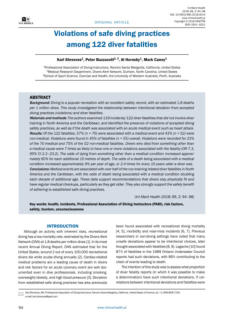

Authors: Ran Arieli
This study investigates the relationship between violations
of accepted diving practices and diver fatalities to
highlight the role of medical events and safety violations in
diving-related deaths, emphasizing the importance of
physical fitness, regular medical checkups, and adherence
to safe diving practices to reduce fatalities. It also provides
statistical data and conclusions to support these
recommendations.




09 - Variability in circulating gas emboli after a same scuba diving
Exposure.
Author: V. Papadopoulou, P. Germonpré, D. Cosgrove,
R. J. Eckersley, P. A. Dayton, G. Obeid, A. Boutros,
M.-X. Tang, S. Theunissen, C. Balestra
This study examined venous gas emboli (VGE) variation in
14 divers after standardized dives. Results showed
significant differences between individuals in VGE
detection and scores, with some divers showing varying
results even on consecutive dives. More research is
needed to understand these differences and improve
detection methods for decompression stress.
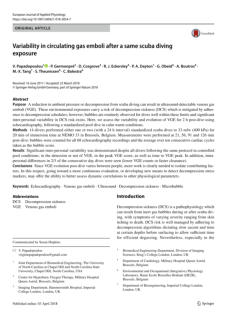



10 - Extravascular Hydrophobic Surfaces, Fat Droplets, and the
Connection With Decompression Illness: Spinal, Joint Pain, and
Dysbaric Osteonecrosis.

Author: Ran Arieli
Decompression bubbles form from existing gas
micronuclei, which can grow into nanobubbles on lipid
droplets during pressure changes. When these bubbles
expand in rigid places like bones or joints, they can cause
harm. Nanobubbles can form on hydrophobic surfaces in
the body, potentially leading to DCI symptoms.
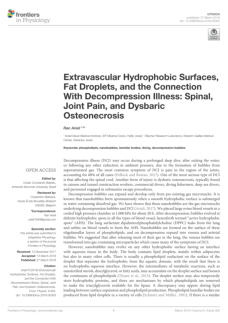



32 - Effects of sleep and fatigue on teams in a submarine
environment

Authors: Sarah Chabal, Rebecca Welles, Lt.Cmdr. F. Jay
Haran, Rachel Markwald
Successful submarine operations depend on tactical
teams working under fatigue. Sleep loss and circadian
disruption cause this fatigue, but little is known about its
effect on team performance in submarines. This review
discusses factors in team fatigue research, the impact of
sleep on submariners, the effects of individual fatigue, and
its influence on team performance. Future research
should focus on the relationship between sleep and team
dynamics.
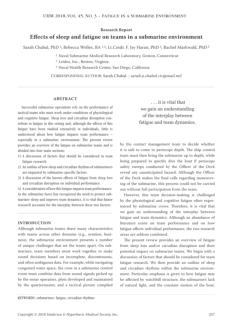



33 - The Gradient Perfusion Model Part 1: Why and at what sites
decompression sickness can occur.

Authors: Michael B Strauss, Lientra Q Lu, Stuart S. Miller
This first part of a series discusses the reasons and
locations of DCS. Over 50 years and 500 cases, it became
clear that most “unexplained DCS” cases have
physiological reasons. Variability in tissue blood flow and
pressure gradients contribute to bubble formation. The
Gradient-Perfusion Model explains these cases, suggesting
that the term “unexplained DCS” should be replaced with
“disordering events.
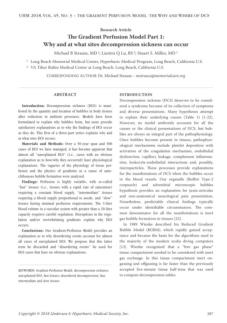



34 - The Gradient Perfusion Model Part 2: Substantiation of the GPM
with clinical cases.
Authors: Michael B Strauss, Lientra Q Lu, Stuart S. Miller
Part 1 of this series explained why and where
decompression sickness (DCS) happens using the
Gradient-Perfusion Model (GPM). This 2nd part provides
evidence and clinical cases previously labeled as
“unexplained DCS,” which later showed disordering
events as causes. 500 DCS cases over 50 years were
reviewed, finding that some previously unexplained cases
had identifiable causes. The results show that gradient-
perfusion connections explain the clinical findings,
suggesting that “unexplained DCS” should be replaced
with “DCS due to disordered decompression”.
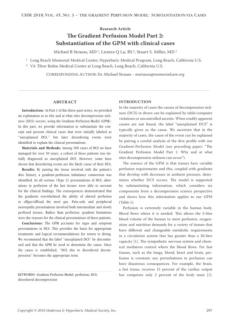



35 - The Gradient Perfusion Model Part 3: An extraordinary case of
decompression sickness.
Author: Lientra Q Lu, Michael B Strauss, Stuart S. Miller
Decompression sickness (DCS) can occur in unusual
situations like breath-hold diving. A 72-year-old healthy
Hispanic woman experienced lower-leg paralysis after
using a homemade hyperbaric chamber. She was treated
with hyperbaric oxygen therapy after reporting
abdominal pain and paralysis. Following this treatment,
she fully recovered. This case illustrates "disordered
decompression," suggesting that a "steal" syndrome may
have caused her symptoms by affecting blood flow to
tissues.




36 - Blood Gene Expression and Vascular Function Biomarkers in
Professional Saturation Diving.
Author: Fatima Z. Kiboub, Andreas Møllerløkken, Astrid
Hjelde, Arnar Flatberg, Øyvind Loennechen,
and Ingrid Eftedal
This study looked at gene expression and certain blood
markers related to blood vessel health. It involved 20 male
divers, with 13 taking vitamin C and E supplements during
dives that lasted 7 to 14 days. Blood was taken before and
after saturation, showing changes in gene activity related
to oxygen transport and immune response. Antioxidant
supplements did not impact these changes, indicating the
divers maintained balance through their natural defenses.
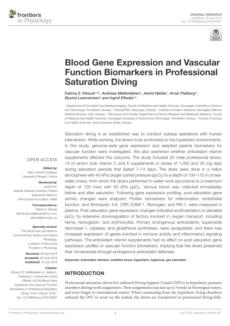



37 - Indices of Increased Decompression Stress Following Long-
Term Bed Rest
Author: Mikael Gennser, S. L. Blogg, Ola Eiken, and Igor
B. Mekjavic
Human extravehicular activity (EVA) is important for space
exploration and carries the risk of decompression sickness
(DCS). Researchers used a head-down bed rest (HDBR)
model to study how different resting and exercise
regimens affect venous gas emboli (VGE) formation after
hyperbaric exposure. Eight healthy men took part in five
hyperbaric exposure interventions during HDBR. Results
showed low VGE levels, but higher levels were found
when HE occurred at the end of HDBR. Future studies
need to explore reasons for these findings.
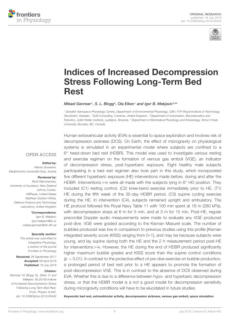



38 - Provocative decompression causes diffuse vascular injury in
mice mediated by microparticles containing interleukin-1 Beta
Author: Stephen R. Thom, Veena M. Bhopale, Kevin Yu,
and Ming Yang
Provocative decompression leads to wide-ranging
vascular injury in mice due to micro-particles carrying
interleukin-1Beta. Research shows that during exposure to
high pressure, these particles increase significantly, along
with levels of inflammatory agents. Vascular damage
appears two hours post-decompression and lasts for at
least 13 hours. Blocking IL-1Beta reduces this damage,
indicating its key role in the process.




02 - A Scoring System for Prediction and Risk Stratification of CO2
Narcosis
Authors: Chang Yang, Jing Xi, Sadaf Sheikh,
Anoushiravan Hakim, Soumya Nadella, Suresh
Dhital, Margaret Meier, Onyema Nnanna, and
David Meyers
A previous study involving 607 patients with
hypercapnia found that 188 were diagnosed with CO2
narcosis. The condition, often caused by injudicious use
of oxygen and opioids, increases the likelihood of ICU
admission, intubation, and prolonged hospital stay. This
study developed a scoring system to predict CO2
narcosis, stratifying patients into low, intermediate, and
high risk groups. Early interventions based on this risk
stratification could potentially prevent this condition.
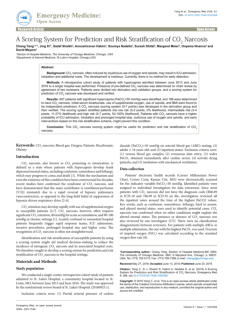



08 - The Effect of Oxygen Enrichment on Cardiorespiratory and
Neuropsychological Responses in Workers With Chronic
intermittent Exposure to High Altitude (ALMA, 5,050 m)
Authors: Fernando A. Moraga, Iván López, Alicia
Morales, Daniel Soza, and Jessica Noack
Chile's labor activity at high altitudes is expected to rise
from 60,000 to 120,000 workers by 2020. Oxygenation
improves the quality of life for workers at these altitudes. A
study aimed to determine the impact of a mobile oxygen
module system on cardiorespiratory and
neuropsychological performance in workers from the
Atacama Large Millimeter/submillimeter Array
radiotelescope in the Chajnantor Valley. Results showed
that using a mobile oxygenation module at 5,050 m,
simulating an altitude equivalent to 2,900 m, significantly
improved cardiorespiratory response and enhanced
neuropsychological performance in workers.
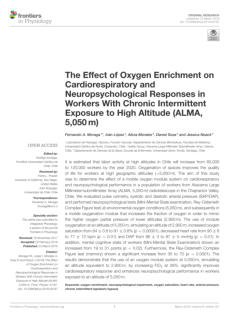



19 - Pain input after spinal cord injury (SCI) undermines long-term
recovery and engages signal pathways that promote cell death
Authors: Joel D. Turtle, Misty M. Strain, Joshua A.
Reynolds, Yung-Jen Huang, Kuan H. Lee,
Melissa K. Henwood, Sandra M. Garraway, and
James W. Grau
This study investigates the impact of noxious stimulation
on spinal contusion injury in rats. It found that both
shock and capsaicin stimulation increased the expression
of TNF and caspase-3, promoting apoptotic cell death.
However, shock led to the expression of signals related
to pyroptotic cell death. Blocking the P2X7 receptor with
Brilliant Blue G reduced the expression of pyroptotic cell
death signals in contused rats. Blocking the pannexin-1
channel with probenecid improved long-term recovery
but did not block the adverse effect of nociceptive
stimulation.
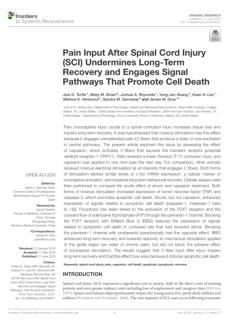


42 - Single-Cell Separation

Authors: Shilpi Pandey, Ninad Mehendale, and Debjani
Paul
Advances in cell biology and diagnostic technology have
necessitated reliable, accurate, and fast techniques for
single-cell separation. Conventional methods like FACS
and MACS are efficient but expensive and bulky. Micro
fluidic technology matches these performance while
being portable and suitable for field use. This chapter
discusses recent advancements in micro fluidics for rare or
single-cell separation.
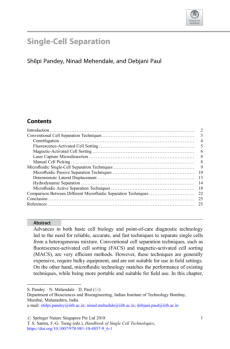

Author: V A Simon, V A Gerasimov, D K Kostrin, L M
Selivanov and A A Uhov
This document discusses challenges in designing a
single-lead electroencephalographic (EEG) monitor for
tracking the depth of narcosis and reveals the
relationship between the level of narcosis and statistical
characteristics of the bioelectric signal. It also describes
the electrical circuit of the developed EEG monitor, as
well as the process for obtaining recordings of the EEG
and ECG signals.


43 - One-channel EEG monitor for tracking the depth of narcosis
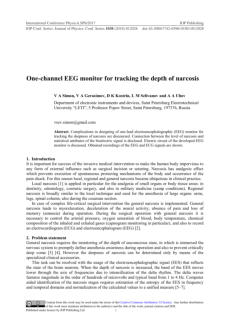


47 - Reactive Oxygen Species Formation in the Brain at Different
Oxygen Levels: The Role of Hypoxia Inducible Factors

Authors: Ruoli Chen, U Hin Lai, Lingling Zhu, Ayesha
Singh, Muhammad Ahmed, and Nicholas R.
Forsyth
Hypoxia inducible factor (HIF) is a key oxygen sensor in
cells, regulating cell responses to varying oxygen levels.
During hypoxia, HIF activation ensures adenosine
triphosphate (ATP) production and cell integrity, but is
associated with reactive oxygen species (ROS) formation.
Changes in oxygen concentrations affect ROS formation,
leading to oxidative stress and HIF stabilization. HIF
accumulation in the brain via HIF prolyl hydroxylase
(PHD) inhibition is proposed as an effective therapy for
ischaemia stroke due to its antioxidation, anti-
inflammatory, and pro-survival signaling properties. HIF
PHD inhibition during reperfusion can reduce ROS
formation and activate cellular survival pathways.




51 - Swimming induced pulmonary oedema in athletes – a
systematic review and best evidence synthesis
Authors: Erik Hohmann, Vaida Glatt, and Kevin
Tetsworth
This study aimed to summarize the evidence on
swimming induced pulmonary oedema (SIPE) in
endurance athletes. A total of 29 studies (174 athletes)
were included, with cough, dyspnoea, froth, and
haemoptysis as the most common symptoms. The study
found a moderate association between water
temperature and SIPE prevalence, with cough, dyspnoea,
froth, and haemoptysis strongly suggesting SIPE during or
immediately following swimming. There is limited
evidence suggesting pre-existing risk factors leading to
SIPE with strenuous physical activity during swimming.












